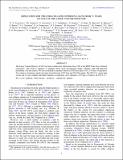IMPLICATION FOR THE CORE-COLLAPSE SUPERNOVA RATE FROM 21 YEARS OF DATA OF THE LARGE VOLUME DETECTOR
Author(s)
Pless, Irwin A.
DownloadAgafonova-2015-IMPLICATION FOR THE.pdf (1.052Mb)
PUBLISHER_POLICY
Publisher Policy
Article is made available in accordance with the publisher's policy and may be subject to US copyright law. Please refer to the publisher's site for terms of use.
Terms of use
Metadata
Show full item recordAbstract
The Large Volume Detector (LVD) has been continuously taking data since 1992 at the INFN Gran Sasso National Laboratory. The LVD is sensitive to neutrino bursts from gravitational stellar collapses with full detection probability over the Galaxy. We have searched for neutrino bursts in LVD data taken over 7,335 days of operation. No evidence of neutrino signals has been found between 1992 June and 2013 December. The 90% C.L. upper limit on the rate of core collapse and failed supernova explosions out to distances of 25 kpc is found to be 0.114 yr[superscript −1].
Date issued
2015-03Department
Massachusetts Institute of Technology. Department of PhysicsJournal
The Astrophysical Journal
Publisher
IOP Publishing
Citation
Agafonova, N. Y., M. Aglietta, P. Antonioli, V. V. Ashikhmin, G. Badino, G. Bari, R. Bertoni, et al. “IMPLICATION FOR THE CORE-COLLAPSE SUPERNOVA RATE FROM 21 YEARS OF DATA OF THE LARGE VOLUME DETECTOR.” The Astrophysical Journal 802, no. 1 (March 20, 2015): 47. © 2015 The American Astronomical Society
Version: Final published version
ISSN
1538-4357
0004-637X